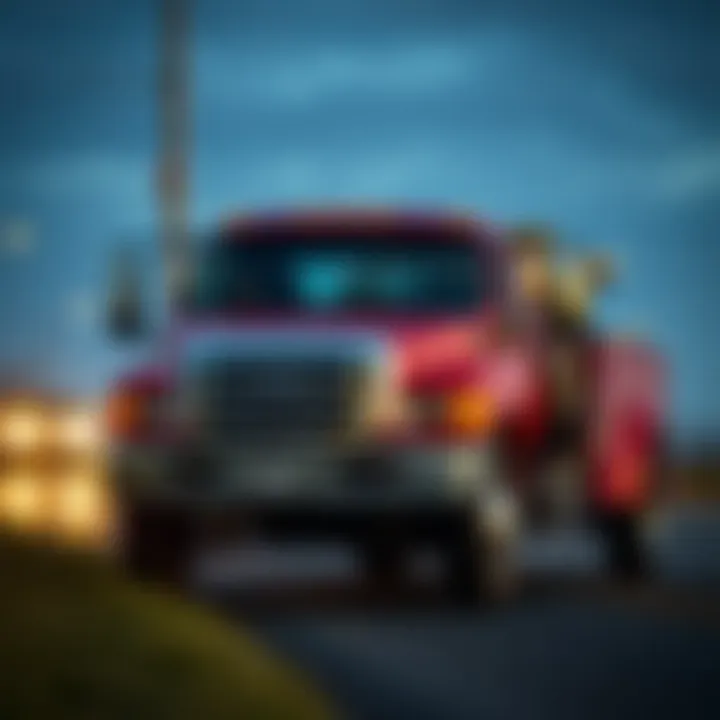Understanding State Farm Towing Insurance Coverage


Intro
Towing insurance coverage is a safety net that many drivers overlook until they find themselves in a bind. With a flat tire, an empty fuel tank, or worse, a breakdown on the side of the road, the peace of mind provided by proper insurance can be invaluable. One notable option in the market is offered by State Farm. This article seeks to pull back the curtain on the nuances of State Farm's towing insurance, highlighting its features, benefits, and the specific conditions that apply.
Understanding the intricacies of this coverage lets drivers appreciate the value it brings, especially in unforeseen circumstances. It’s not just about having a policy; it’s about knowing what it covers and how it can come to the rescue in trying times. We’ll examine real-life scenarios where this coverage plays a critical role and weigh it against competitors to provide readers with a holistic view. Whether you’re a seasoned driver or a newbie, having insights into these options can help in making educated choices.
As we navigate through this topic, it’s important to keep in mind various key terms and definitions that will anchor our discussion.
Prelims to Towing Insurance
When it comes to navigating the unpredictable roads of life, a solid understanding of towing insurance is crucial. Not only does it offer peace of mind, but it also safeguards you against unexpected breakdowns or accidents. You might think of it as a safety net, softening the blow of those unforeseen detours that life, or more specifically, driving, can throw your way.
Imagine you’re cruising down the highway, the sun is shining, and all seems well. Suddenly, your car starts sputtering, and before you know it, you’re pulled over on the side of the road, wondering how to get out of this pickle. This is where towing insurance comes into play. In its essence, towing insurance is the coverage designed to assist motorists when their vehicles break down or meet with an accident. By investing in this kind of insurance, you can mitigate the stress and costs associated with towing services, which can sometimes feel like a punch in the gut unless you have the right coverage.
So, why does towing coverage matter? It’s about more than just having a number to call when your car fails you. It’s about ensuring that a smooth recovery can take place, no matter where you find yourself stranded. It not only provides financial relief but also aids in facilitating a swift return to driving. With various options available, such as roadside assistance and the specifics of coverage limits, understanding how towing insurance fits into your overall auto insurance policy is important. It makes the difference between a minor bump in the road and a major financial stressor.
As we delve further into the details of towing insurance, this section will set the stage for discussing the nuances—what it covers, why it’s a wise choice for every driver, and the specific factors to consider when evaluating your coverage options.
Overview of State Farm Insurance
State Farm has established itself as a formidable presence in the world of insurance, and understanding its foundational framework is essential when considering towing coverage. This section offers a glimpse into the inner workings of State Farm, shedding light on its reputation and the various products it offers, which can serve as a backdrop for the specificities of towing insurance.
Company Background
Founded in 1922, State Farm was initially formed to provide auto insurance for farmers. Over the years, it has broadened its horizons significantly and now stands as the largest auto insurer in the United States. What gives State Farm an edge? It's their commitment to customer service and reliability, which fuels customer loyalty. All these decades in business have allowed them to refine their practices and develop a keen understanding of client needs.
State Farm operates on a mutual insurance model, which means policyholders essentially become stakeholders in the company. Profits can translate into lower premiums or additional services, making it a unique player in the market. It's not just about geographical reach; it's about fostering a relationship built on trust and a user-centric approach, which resonates deeply with customers.
Core Insurance Products
When one thinks of State Farm, a plethora of insurance products come to mind. Here are a few highlights:
- Auto Insurance: Covers various aspects, including liability, collision, and comprehensive coverage, streamlining the process for any vehicular mishap.
- Homeowners Insurance: Provides protection against diverse risks that may affect a homeowner’s investment.
- Life Insurance: Offers security for families through term and whole life plans, addressing both immediate and future financial concerns.
- Health Insurance: While they focus more on property and casualty, there are limited health-related policies available.
- Financial Services: Including banking options, these services round out what they offer to policyholders, showcasing their holistic approach to coverage.
These core products are heavily intertwined with the company's overall vision of safeguarding its clients' assets, making their offerings relevant to a broad audience. Notably, their towing insurance isn't merely an add-on; it’s integrated with their auto policies, aiming to provide comprehensive support when drivers find themselves in a lurch on the road.
In summary, State Farm's features such as its history, customer-centric approach, and extensive range of products lay the groundwork for understanding their towing insurance. Having this context can help consumers appreciate the significance and reliability of State Farm's offerings as they venture into the world of towing coverage.
State Farm Towing Insurance Coverage Details
State Farm's towing insurance coverage is not just a safety net; it’s a lifeline when you find yourself in a jam on the road. When the rubber meets the road—or when a tire runs flat—having the right insurance can make all the difference. This section aims to explore the critical aspects, benefits, and various considerations surrounding State Farm's towing coverage. Understanding these details empowers drivers, helping them to make informed decisions about their insurance needs.
Inclusions of the Coverage
When you opt for State Farm towing insurance, you are generally looking at several key inclusions that can save you time, money, and stress in times of need. Among the primary benefits are:
- Towing Services: This is the heart of the coverage. Should your vehicle break down, State Farm offers towing to the nearest repair facility, making sure that your car is in good hands quickly.
- Jump Starts: If your battery decides to call it a day, you can count on State Farm to provide a jump start. This inclusion can often save you the hassle of waiting for friends or family.
- Flat Tire Assistance: If you step out to find your tire flat as a pancake, don’t fret. State Farm has got you covered for a tire change at your location, so you can get back on the road faster.
- Fuel Delivery: Running out of gas is not just unfortunate, it can be downright embarrassing. With this coverage, you will have fuel delivered to your location to help you get back on your journey.
- Lock-Out Assistance: Ever locked your keys in your car? With towing insurance, State Farm can assist with unlocking your vehicle, provided you can prove ownership.
These inclusions simplify what could be a chaotic experience, turning troubles into minor inconveniences.
Exclusions and Limitations
While the coverage includes various services, it's equally important to understand what it doesn't cover. Here's where potential pitfalls can sneak up on you:
- Pre-existing Conditions: If your vehicle had issues before the policy was enacted, those are usually not covered, given that they fall under the category of existing problems.
- Aftermarket Modifications: Changes made to your car after purchase might pose a problem. For instance, if you've heavily modified your vehicle for performance, certain included services may become void.
- Geographical Limits: Some towing services may only be valid within specific boundaries. Traveling out of state might lead to complications, as certain services could be limited to your home state.
- Service Frequency Caps: Depending on your plan, there may be a cap on how often you can claim towing services within a given timeframe.


Being aware of such exclusions is vital for any driver to avoid unpleasant surprises when trouble strikes. Always read the fine print to avoid misconceptions.
Geographical Restrictions
Geographical restrictions can turn what seems straightforward into a maze of complications. Depending on where you are located, the extent of your coverage might differ:
- In-State vs. Out-of-State: Typically, towing coverage holds up well in-state, but when you venture into neighboring states, limitations may apply. Always check how far from home you’re covered.
- Urban versus Rural Areas: Services can vary greatly between city and country settings. In more remote locales, response times may be longer or even limited.
- Off-Roading Limits: If you're a weekend warrior who likes to take the vehicle off the beaten path, it’s prudent to remember that towing coverage may not apply in off-road situations.
Thus, understanding these geographical limits is not just an academic exercise; it’s an essential part of ensuring that you're fully prepared and protected, no matter where the road may lead.
How to Enroll in State Farm Towing Coverage
Understanding how to enroll in State Farm's towing coverage is essential for anyone considering this specific insurance option. It's not just about having a peace of mind when you're on the road, but it also ensures that you're adequately protected when mishaps happen—offering valuable assistance when you find yourself stranded due to vehicle trouble. Enrolling in this coverage can seem daunting at first, but breaking it down into manageable steps can simplify the process.
Steps to Add Coverage
Adding towing coverage to your existing State Farm policy is a straightforward process. Here’s a step-by-step guide:
- Review Your Current Policy: Before you start, take a moment to understand your existing coverage. This will help you identify any gaps you may want to fill with towing insurance.
- Visit the State Farm Website or App: You can initiate the process online. Navigate to your policy management section.
- Contact Your Agent: If you prefer personalized service, talking directly to your State Farm agent can provide clarity. They can help outline options tailored to your specific needs.
- Complete the Necessary Forms: Be prepared to fill out brief forms that detail your vehicle and driving habits. Your agent or the online portal will guide you through this.
- Review Terms and Conditions: Closely examine what is included in the coverage, as well as any limitations.
- Finalize Your Enrollment: After verification, confirm your coverage, and ensure you're aware of the effective date.
By following these steps, you can efficiently add towing insurance to your current policy, securing additional protection when you need it most.
Eligibility Requirements
Enrolling in towing coverage isn't just about desire; there are eligibility requirements to consider. Here are key points:
- State Farm Policyholder: You must already have a policy with State Farm. This insurance typically stacks seamlessly with your current coverage.
- Vehicle Qualifications: Not all vehicles may qualify for towing insurance. Generally, personal vehicles that are in good standing with your policy are eligible. Commercial vehicles may have different requirements.
- Payment Status: Ensure that your premiums are up-to-date. Any lapses in payment can jeopardize your ability to add coverage.
- Geographical Considerations: Be aware that certain regions may have different rules regarding coverage eligibility due to local regulations or service availability.
With these criteria in mind, you can assess whether you meet the requirements before proceeding with your enrollment in State Farm towing coverage.
Claim Process for Towing Insurance
Understanding the claim process for towing insurance is crucial for anyone who holds a policy with State Farm. This segment not only elaborates on how to effectively file a claim but also emphasizes the common challenges one might encounter along the way. Being informed about these elements can significantly reduce stress and confusion in those momentary crises on the road. Knowing the ins and outs of this process helps road users to navigate the rough waters of insurance claims with confidence.
How to File a Claim
When it comes to filing a claim with State Farm for towing insurance, the approach is rather straightforward, but it does necessitate a few key steps. Below are the actions to take:
- Gather Information: Ensure you have all pertinent details on hand. This includes your policy number, the incident's date and time, and any receipts or reports from the towing service.
- Contact State Farm: The quickest way to initiate the process is via their app, website, or by calling a representative directly. This initial contact is vital for setting the wheels in motion.
- Fill Out the Claim Form: You’ll be required to complete a claim form, which outlines the details of the incident. Take care to provide accurate information as this can affect processing time.
- Submit Documentation: Once your form is filled out, submit it along with all accompanying documents. Make sure to retain copies for your own records.
- Follow Up: After submission, it's wise to follow up to confirm that your claim has been received and is being processed. Keeping in touch can help address any issues that might arise along the way.
Timeframes for Processing Claims
The horizon for receiving claims can vary, but typically, State Farm aims to process towing insurance claims within 7 to 10 business days. Factors influencing this timeframe include:
- Complexity of the Claim: More complicated cases may require extended review, which can delay a decision.
- Claim Volumes: During peak times, such as winter months or holiday seasons, processing can take longer due to high demand.
- Documentation Integrity: Missing or unclear information can lead to processing stalls, and following up can mitigate such issues.
Common Issues in Claims
The road to claiming towing insurance can be bumpy, with several frequent pitfalls:
- Incomplete Claims: Many people jump the gun and submit claims without all the necessary information. This can lead to delays and even denials.
- Lack of Understanding of Coverage Limits: Not knowing the specifics of what is covered might lead to frustration later on if certain services are denied.
- Time Constraints: Waiting too long to file a claim, especially past the specified time limit, can lead to a lost claim opportunity.
It's essential to be proactive and meticulous when managing claims. This not only saves time but can also make a potentially stressful situation a lot easier.
By having a clearer understanding of these aspects, policyholders can ensure that they deal with any claiming mishaps effectively. Stay informed; it pays off.


Comparative Analysis with Other Insurance Providers
When considering towing insurance, it's crucial to take a deeper look into how State Farm compares with other insurance companies. Such an analysis can provide valuable insights for potential policyholders. Understanding what others offer not only clarifies your options but also helps to spotlight the strengths and weaknesses of State Farm's coverage. Just like trying different flavors before settling on your favorite ice cream, examining multiple providers can truly shape your decision-making process.
A comparative analysis also encourages awareness of the industry standards. Each insurance company has its own offerings, and knowing how they stack up against one another can spotlight unique features that might serve your needs better. Furthermore, it assists in evaluating the value of premiums in relation to the coverage offered.
Similar Coverages in the Market
Many insurance companies present towing insurance that appears similar on the surface, but the details can vary significantly. For instance, companies like Allstate, Geico, and Progressive all have their versions of towing coverage. Allstate may offer coverage that includes successful towing without a maximum number of miles, while Geico offers a higher limit on their roadside assistance limit. Progressive provides a similar service structure, yet might have varied additional perks.
It’s wise to examine the nitty-gritty details:
- Allstate: Unlimited tow mileage depending on selected plans.
- Geico: Offers 24/7 roadside assistance combined with accident forgiveness.
- Progressive: Variable towing distance options based on chosen policy settings.
Key Takeaway: Don’t just scratch the surface; delve into the small print to ascertain true value and what fits your situation best.
Cost Comparisons
Dollars and cents matter a lot when choosing insurance. The cost of towing coverage can swing widely, influenced by factors such as local market conditions, service quality, and the specific coverage features. State Farm often presents competitive rates compared to other major players.
For instance, an Allstate customer might find the towing feature costing around $20 extra each year, while Geico may charge closer to $15. On the other hand, Progressive may have a slightly higher upfront cost but offers additional coverage options that might justify this.
Here’s a quick summary of average costs:
- State Farm: $12 per year for basic towing coverage.
- Allstate: Approximately $20.
- Geico: Around $15.
- Progressive: Starting at about $18.
Bottom Line: Evaluating these costs enables consumers to find a balance between affordability and comprehensiveness.
Customer Satisfaction Ratings
Customer feedback often reveals a wealth of information that you can't find in product brochures or price lists. Ratings on well-known platforms such as J.D. Power can illuminate the satisfaction level of clients for various insurance providers. How policyholders perceive their experience can be a real game-changer.
State Farm receives consistently high marks, often ranking in the top tiers for customer service and claims satisfaction. However, companies like Allstate and Geico showcase solid ratings as well, indicating a relatively pleasing experience for their customers. On the flip side, Progressive sometimes garners mixed reviews, particularly when it comes to ease of claiming.
In summary, the following highlights the customer satisfaction ratings of different providers:
- State Farm: 4.5 out of 5 stars.
- Allstate: 4 out of 5 stars.
- Geico: 4.2 out of 5 stars.
- Progressive: 3.7 out of 5 stars.
"A happy customer is the best business strategy of all."
Understanding customer sentiment can ultimately influence your buying decision; a good rating often reflects a company’s reliability.
Rider Options and Customization
When it comes to insurance, being able to tailor coverage to fit individual needs is not just a luxury; it’s essential. This is particularly true for State Farm's towing insurance. The idea of rider options and customization stands pivotal in navigating the complexities of your policy. It's like having a tailor-made suit, rather than one straight off the rack.
Customization allows you to adapt your towing coverage to your unique driving habits and lifestyle. Whether you spend long hours on the highway or mostly drive around town, the right options can help ensure that you have adequate protection in cases of vehicle breakdown or accidents. With State Farm, you can explore various features that can enhance or fine-tune your coverage, ensuring that you’re not paying for what you don’t need while getting robust protection for what truly matters.
- Customized Add-Ons: You can opt for additional features that bolster your coverage. Perhaps roadside assistance or reimbursements for certain expenses that may occur during a towing incident.
- Adaptability: Different life stages might call for different coverage levels. Whether your kid just got their first car or you’re buying a vintage vehicle, State Farm enables flexibility. You can add or remove riders according to your current situation.
The importance of these rider options cannot be overstated. It permits you to address potential vulnerabilities in your coverage, which might not be immediately apparent.
Additional Features Available
Among the menu of options that State Farm offers, additional features can significantly enhance the standard towing coverage. These are designed to cover various aspects of towing, helping to ensure you aren’t left out in the cold when you need assistance the most.


For instance, towing reimbursement helps cover the costs incurred when your vehicle needs to be towed after a breakdown. This feature ensures you won't be left to absorb those costs on your own, and a bit of financial relief can go a long way in an already stressful situation.
- Roadside Assistance: Provides emergency services such as fuel delivery, minor repairs, or a jump start when your car doesn't cooperate. It’s that extra layer of security that can make all the difference during an unexpected roadside incident.
- Trip Interruption Coverage: This kicks in if a breakdown occurs during a predetermined trip. It can cover additional living expenses like hotel stays or meals until your vehicle is operational again.
In many ways, these additional features serve as safety nets, catching you when unforeseen hiccups occur during travel. Not only do they provide peace of mind, but they also allow drivers to focus on reaching their destinations without the nagging worry of potential setbacks.
Flexibility in Coverage Additions
Flexibility is one of the strongest suits when it comes to choosing insurance coverage. State Farm recognizes that life is unpredictable; thus, they allow for a considerable amount of leeway when it comes to policy adjustments.
If you find that your driving patterns change or that your vehicles require different types of coverage as time goes on, having flexible options is like having a reliable GPS in an unfamiliar area. It can guide you through possible routes and ensure you arrive safely. With State Farm, you can easily modify your policy.
- Seasonal Adjustments: If you’re a seasonal driver—say, if you only hit the road during summer or winter—you can adjust your coverage during those periods as needed. This flexibility can potentially save you a chunk of change.
- Group Coverage Options: For families or friends pooling resources, there’s the possibility to combine different riders under one umbrella plan. It can lead to cost savings while still ensuring that all members have adequate protection.
In summary, rider options and customization in State Farm’s towing insurance is more than just an opportunity; it’s a necessity for those who want to be adequately prepared for any circumstance while on the road. With customizable riders and flexible options, you can engineer a plan that covers your specific needs, offering the reassurance that you won’t face unforeseen challenges unprepared.
"Remember, each vehicle, driver, and circumstance is unique—what works for one may not work for another."
By considering the personalization opportunities State Farm offers, you can ensure a more accurate safeguard for your journeys.
Potential Pitfalls to Consider
When diving into the realm of towing insurance, particularly with State Farm, it’s crucial to recognize potential pitfalls that may arise. Understanding these risks can make the difference between having peace of mind and facing unwanted surprises when you need assistance.
Under-Insurance Risks
One of the most significant challenges in acquiring towing insurance is the risk of under-insurance. This occurs when the coverage purchased is insufficient to meet actual needs. Many often underestimate the potential costs associated with towing services, especially in different geographic locations. For instance, a tow in an urban environment might run quite a bit more than in rural areas. Pricing can vary based on factors such as distance, type of vehicle, and even the time of day.
Suppose you’ve opted for a basic plan with a low coverage limit—this might seem like a great way to save some cash at the onset. However, if you find yourself in a situation requiring an $800 tow, having coverage that only extends to $200 can leave you significantly out of pocket.
To mitigate this risk, it is crucial to thoroughly assess likely scenarios based on your locations and personal circumstances. This means considering not only the average cost of towing in your vicinity but also any additional fees that might be tacked on, like those for after-hours towing or specialized handling for larger vehicles.
Overlooking Important Details
Another pitfall is the tendency to overlook important details when reviewing policies. Many get swept up in the excitement of acquiring coverage but fail to meticulously read the fine print. This can lead to confusion when it matters most, especially during the claims process. One common trap is assuming that all towing incidents are covered under the policy.
For instance, certain policies may have exclusions that limit coverage to specific types of breakdowns, or they might have geographical limits that apply only to certain counties. Additionally, many might not realize that often, roadside assistance comes with stipulations around when and how it can be utilized. Failing to understand these details could result in claims being denied, leaving individuals responsible for costs they thought were covered.
To avoid these scenarios, always make it a point to review your insurance documents carefully, paying close attention to the specifics of what’s covered, how services can be accessed, and any associated costs.
“The devil is in the details.” This adage rings particularly true in the context of insurance, where small oversights can culminate in significant consequences.
By proactively addressing these pitfalls, consumers can navigate their insurance choices more effectively. Understanding the nuances involved with coverage options is essential in ensuring you’re genuinely protected during necessary towing incidents.
Finale and Final Thoughts
Navigating the world of towing insurance coverage can be quite the maze, but forming a clear understanding is crucial. State Farm’s towing coverage offers a range of benefits that any car owner should seriously consider. As we focused throughout the article, these details are not just technical jargon; they hold real significance when you find yourself stranded on the roadside. Whether you own a compact car or a massive SUV, knowing what State Farm brings to the table can ease a lot of worries.
Recap of State Farm Towing Coverage
In summary, State Farm provides substantial towing insurance coverage designed to cater to various needs. We discussed how it includes vital services such as roadside assistance, battery jump-starts, and fuel delivery, which can be lifesavers in tricky moments. Additionally, the policy generally covers towing to the nearest licensed repair shop or the location of your choice, which adds flexibility to a stressful situation.
Beyond this, there are provisions to upgrade your plan, allowing for a more tailored experience. The fine print, including exclusions and limitations, is where the true understanding lies. For example, costs can vary based on factors like location and the type of vehicle, so it’s wise to consider those unique conditions when selecting your coverage.
Making an Informed Decision
When it comes to making an informed decision, knowledge is your best friend. Weighing all aspects of State Farm’s towing insurance against your individual needs will empower you to choose wisely. Think about how often you travel, the distance you cover, and the kind of support you would need in case of a breakdown.
It's also a good idea to look into how the coverage stacks up against competitors. At the end of the day, it’s about selecting a policy that meets your requirements without overpaying. Reading reviews and comparing ratings can reveal insights into customer satisfaction which is indispensable.
"An informed choice today can save on opportunities lost tomorrow."
Taking the time to assess your options, considering all the details we've laid out, can set you on the right path in your towing insurance journey. So, remember, when you know what you need, the entire coverage selection process becomes far less daunting. Stay prepared, and drive with peace of mind!







